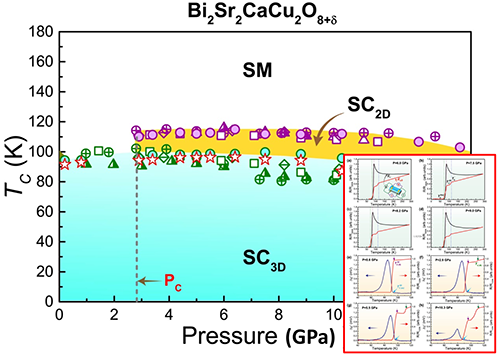

To decipher the mechanism of high temperature superconductivity, it is important to know how the superconducting pairing emerges from the unusual normal states of cuprate superconductors, including pseudogap, anomalous Fermi liquid and strange metal (SM). A long-standing issue under debate is how the superconducting pairing is formed and condensed in the SM phase, because the superconducting transition temperature is the highest in this phase. Although a lot of theoretical progress on the superconducting mechanism of these high-TC superconductors has been made, a unified understanding on how the SC state connects with these unusual normal states is still lacking. Because the SM state of the optimally-doped superconductor not only can develop the SC state with the highest TC but also links the PG and the anomalous FL states, it is of great interest to take the SM state as a breakthrough point to further reveal the underlying physics of cuprate superconductors.
Recently, a team led by Professor Sun Liling at the Institute of Physics (IOP), Chinese Academy of Sciences, chose the optimally-doped Bi2Sr2CaCu2O8+δ (Bi-2212) single crystal, a typical nearly-two-dimensional high-Tc superconductor with the SM normal state, and widely studied in recent years, as the investigated material. They performed high pressure studies on these samples through state-of-the-art in-situ high-pressure measurements of resistance, magneto-resistance and magnetic susceptibility and discovered a pressure-induced crossover from two- to three-dimensional superconducting states in the optimally-doped Bi2Sr2CaCu2O8+δbulk superconductor at a pressure above 2.8 GPa. They found that the two-dimensional (2D) superconductivity bridges the SM state and 3D superconducting state and that the two-dimensional (2D) superconducting transition exhibits a Berezinski-Kosterlitz-Thouless-like behavior. These results provide direct and strong evidence that the SM state is predominantly 2D-like.

Figure 1: Pressure-TC phase diagram of optimally-doped Bi2Sr2CaCu2O8+δ. The acronyms of SC2D and SC3D stand for 2D (BKT-like) and 3D superconducting states, respectively. SM represents strange metal state. PC represents the critical pressure above which the 2D superconductivity emerges from the SM state. The lower right panel of the figure (a)-(d) show Rab(T) and Rc(T) measured at different pressures, while the figure (e)-(h) display Δχ′(T) and R/R120K at different pressures. The purple and green arrows indicate TC3D and TC′, the cyan arrow indicates the TC3D probed by the AC susceptibility measurements.
In this study, they were the first to perform the combined in-situ high-pressure measurements of AC susceptibility and resistance for the same sample in the same diamond anvil cell. This kind of measurement is a technical challenge because integrating the standard four-probes for the resistance measurement and the coils for the AC susceptibility measurements into the same pressure cell is very difficult, indicating that the high pressure technique adopted in this study is among the highest-level techniques in the world.
The high-quality single crystals investigated in this study were provided by Genda Gu from Brookhaven National Laboratory, USA, whose samples of Bi-2212 have been widely studied using other methods. High pressure X-ray diffraction measurements were performed at 15U beamline at the Shanghai Synchrotron Facilities.
These results have been published on Nature Physics. Guo Jing, Zhou Yazhou and Huang Cheng are the first co-authors (https://www.nature.com/articles/s41567-019-0740-0.pdf).
The study was supported by the National Science Foundation, the Ministry of Science and Technology of China, the Chinese Academy of Sciences and grants from the US.
For more information, please contact:
Professor Sun Liling
Institute of Physics, Chinese Academy of Sciences
E-mail:llsun@iphy.ac.cn
Source: Institute of Physics,Chinese Academy of Sciences